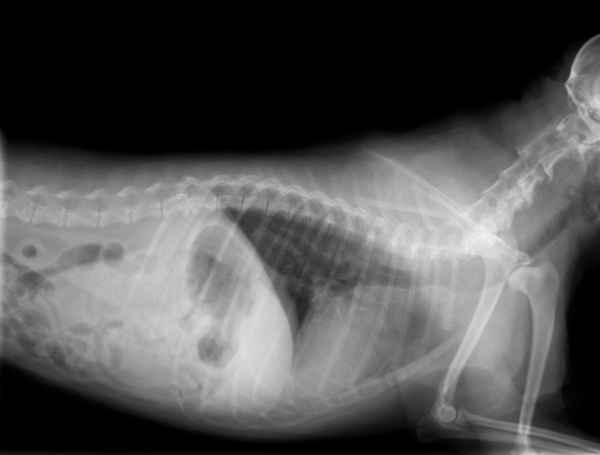
This article was updated on March 19th, 2024
Dogs can sometimes get themselves into trouble by eating objects that they aren’t supposed to ingest. Occasionally, the foreign object that’s ingested will pass right out of the other end. But what if your dog has eaten a tampon?
The health outcome for dogs who eat tampons is variable. If you suspect that your dog may have eaten a tampon, have a vet evaluate them to determine the best course of action. Choking, injury to the digestive lining, and intestinal blockage are all possible and potentially life-threatening.
7 Important Things to Know about A Dog Who Just Ate a Tampon:
Here are 7 things you should know according to our veterinarian Dr. Baiz-Chen and Dr. Whittenburg:
1. Dogs smaller than 15-30 pounds are more likely to have issues with a tampon
The size of your dog relative to the tampon ingested is important. The smaller the dog is, the smaller the intestines are. A smaller intestinal width means that it is more likely that a tampon will get stuck.
If your dog is smaller than 30 pounds and especially less than 15 pounds, it is very possible that your pup will have problems with passing the tampon. Your dog’s GI tract may be damaged and they may need surgery.
It is possible that a tampon could pass through a larger dog’s intestinal tract unharmed, but there are times when even large dogs have problems passing a tampon. While size is one factor, there is no way to reliably predict whether your dog will have any issues, as Dr. Baiz-Chen explains:
“Unfortunately, no veterinarian can confidently predict whether a dog will be able to pass a tampon that they’ve eaten without any medical complications. If your dog eats a tampon, immediately consult with a vet so that steps can be taken to remove the tampon before it reaches the small intestines.”
Dogs with pre-existing health conditions such as digestive problems and bleeding conditions may have a worse outcome.
2. Visit the vet ASAP if you see these signs
If your pup is showing the following signs, please call their regular veterinarian immediately. If the regular vet is not available right away, take your dog to an emergency vet clinic.
- Vomiting, especially if multiple times in a short amount of time
- Difficulty breathing or gagging
- Activity level significantly decreased from normal
- Collapse or not wanting to get up
- Blood in vomit or stools
- Your pup is a small dog (roughly less than 30 pounds)
- **If your dog has no symptoms, but just ate a tampon in the last 2-4 hours, your vet may be able to remove the tampon by inducing them to vomit**
Swallowing a tampon may cause potentially life-threatening issues including choking, GI damage and intestinal blockages – so it’s important to check with your vet asap (see section 5 later in this article).
3. You have up to 4 hours for vet-induced vomiting
Inducing vomiting at a vet clinic is usually the best option as long as less than ~4 hours has passed since time of ingestion:
- When did your dog eat the tampon? If in the last 2-4 hours, take your dog to the vet immediately. Call your regular vet first about availability, or go straight to the emergency clinic. The vet may recommend inducing your pup to vomit.
- If your dog ate the tampon over 4 hours ago, call your vet for advice. They may still recommend that you bring your pup in for evaluation and possible x-rays.
4. Some dogs will pass a tampon through the gastrointestinal tract naturally
In some cases, ingestion of a tampon likely won’t cause any problems, and a dog could pass the tampon through the GI tract naturally. These cases usually involve larger dogs that are young and healthy and are acting normal with no symptoms. However, any dog who ingests a tampon could end up with an obstruction. I always recommend calling your vet for advice because each dog’s situation varies.
Monitoring your dog’s symptoms:
- Pay special attention to your pup’s appetite after tampon ingestion. Eating less may mean discomfort due to intestinal injury or obstruction.
- Monitor their energy level
- Check their stools for any diarrhea, blood, or the tampon. If you see a tampon in the stools, your pup is likely in the clear!
- Make sure your dog is not vomiting
5. Swallowing a tampon may cause choking, GI damage and intestinal blockages
1. Choking
A dog’s airway is connected to the mouth and the nose. Usually there is a flap of tissue that covers the airway while eating to prevent food from entering. Sometimes food or other objects can accidentally block the opening or go down the wrong tube and cause choking.
Due to a tampon’s size and shape, ingestion of a tampon could potentially lead to choking and loss of oxygen to the lungs. If you notice your dog coughing violently or struggling for air after eating a tampon, immediately take your dog to the vet.
2. Injury to digestive lining
Materials that are not digestible food can cause injury to the gastrointestinal tract. The larger an object is compared to the size of the dog, the more likely it is that the object will cause irritation or a tear.
For example, ingestion of a large object with sharp edges, such as some tampon applicators, could cause irritation of the esophagus (esophagitis) and lead to pain while eating and swallowing. Damage to the intestinal tract can occur as well. This can lead to pain, vomiting, decrease in appetite, diarrhea, and bleeding.
3. Intestinal blockage
Intestinal blockages are serious medical problems and need to be treated immediately. A tampon can become lodged in the stomach or small intestines and cause significant problems. A worse outcome may occur if the tampon has expanded in size and length and has a string attached. Here is a diagram of intestinal blockage caused by a ball.
If the tampon blocks anything else from moving through, then liquid, air, and other food can back up in the gastrointestinal tract. This causes severe pain, abnormal expansion of the stomach or intestines, and damage to the tissue.
“In very severe cases, a tampon obstructing the GI tract can lead to severe, life-threatening problems. The injury can cause rupture of the intestines or stomach. This leads to bacteria leaking into the abdomen or the bloodstream, causing widespread infection. Sometimes, the string of a tampon can become stuck in one area of the intestine while the other part of the tampon moves through, pulling the intestines together in a bunch and causing tissue damage.”
6. Diagnosis at the vet may cost anywhere from $70 to $500
Each dog’s chance of passing a tampon safely or having it removed is different. The more information the vet can obtain, the better they can guide you in next steps to help your dog.
Triage
If you take your pup to the emergency, the first thing the vet staff will do is triage your pup. They will find out why you are there and do a quick evaluation of your dog’s vital signs to determine how urgent the problem is.
Inducing your dog to vomit (cost ~$100-$200)
“Inducing your dog to vomit at home is not recommended if taking your dog to the vet is an option. This procedure could be more risky in extremely small dogs, elderly or frail dogs, and dogs with pre-existing medical conditions. Complications like choking are rare, but it is best to have vet staff to address any problems if they occur.”
At a vet clinic, the most common way to induce vomiting is by giving an injectable drug called apomorphine, which is almost 96% effective. The vet staff will monitor your dog during this process. They can intervene if any problems occur and will check the contents of what comes up. One of the normal side effects is sleepiness after receiving the injection.
Occasionally, inducing a dog to vomit does not work, or the dog vomits but the tampon does not come back up. The vet may give an option for performing endoscopy. This procedure involves using a long tool with a camera to retrieve the tampon while your pup is anesthetized.
Examination (cost $50-$130)
The vet will perform an examination and may focus on things like whether your dog has pain in the abdomen and if they’re dehydrated.
Diagnostic blood and urine testing (cost $200-$500)
In some instances, the vet will recommend blood and urine testing for your dog. The purpose of that is to get a better idea of their current condition and to identify potential internal problems like blood loss, electrolyte imbalances, or infection secondary to tampon ingestion. Usually, vets want more information when the dog is in shock, has other severe symptoms like non-stop vomiting, has pre-existing health problems, or if it’s likely your dog will need a procedure under anesthesia.
Diagnostic imaging (cost for x-rays $300-$500, abdominal ultrasound $400-$700)
The vet may recommend testing such as x-rays or an abdomen ultrasound. This can help determine where the tampon is in your dog’s body and whether there is a problem such as an obstruction.
An obstruction means that in addition to the tampon being in the small intestines, it is causing gas buildup due to it blocking the entire space where it’s lodged. This gas buildup is typically visible on a set of x-rays. If an abnormal gas pattern is present, the vet may recommend surgery to open that intestinal segment and remove the tampon.
Example of a dog’s abdomen x-ray:

7. Treatment options are there for dogs who eat tampons
Endoscopy (cost $800-2000)
In some instances where a dog recently ate a tampon but did not successfully vomit the tampon back up, a vet can remove the tampon via a long, flexible tube with a grabbing mechanism at the end. This is only recommended if the stomach is empty and the tampon is still visible in the stomach on x-rays.
Gastric and intestinal surgery (cost $2000-$10,000)
It is possible that the tampon may get stuck in the area right before the small intestine (pyloric outflow obstruction). This will usually cause severe and sometimes projectile vomiting and needs to treated with surgery to open the stomach and remove the tampon.
If the tampon passes into the intestines and causes a blockage, intestinal surgery will be recommended. In surgery, the vet will determine if removal of the tampon will suffice or if some intestinal tissue is damaged beyond repair and needs to be removed.
Gastrointestinal surgeries can be costly, have risk of complications, and take a few weeks to heal. It is better to prevent a possible obstruction by removing the tampon, either via inducing vomiting or with endoscopy.
“Timing is important when a dog eats a tampon. After 4 hours or so, the window to remove the tampon from the stomach is gone and it is up to chance whether your dog passes the tampon on their own or will need surgery.”
Supportive care and monitoring at home or in the hospital (hospitalization cost $500-$3000)
If an abdomen x-ray shows that a tampon is in the intestines but is not causing any obstruction, the vet may recommend monitoring at home or in the hospital.
Monitoring at home may be an option for larger, young, previously healthy dogs who do not have any symptoms and are acting normally.
For dogs who are smaller, elderly, have other medical conditions, or who feel sick with vomiting, lethargy, abdomen pain, or dehydration, the vet will probably recommend keeping your pup in the hospital for the staff to monitor. This way, the vet can make sure the tampon is making its way through the GI tract without problems by withholding food and taking recheck x-rays every 12-24 hours.
Supportive treatments to help your pup feel comfortable while waiting for the tampon to pass include anti-nausea and anti-diarrheal medications, fluids for hydration, and pain medications.
Sometimes the plan will have to change if a dog’s symptoms worsen or if x-rays are concerning for an obstruction in the intestines. The vet may recommend surgery at any time during this process before the tampon comes out of the back end.
Questions your vet may ask you
Veterinary staff may ask some of the following questions after you tell them your dog ate a tampon. It is a good idea to know details if you can.
- How many tampons, how much of the tampon, and what parts of the tampon were eaten? What kind of material was it (plastic, cotton, etc)?
- When do you think your dog ate the tampon? If your dog ate the tampon within the last 2-4 hours or so, make sure to let the vet staff know. They may recommend inducing your dog to vomit to prevent potential intestinal problems.
- How certain you are that your dog ate a tampon? Did you see your dog swallow it, or are you just suspicious because there’s an empty tampon box?
- What symptoms has your dog shown since eating the tampon and when did the symptoms start?
- Any important information about your pup’s medical history, such as medication, allergies, and chronic health problems?
Prevention is Preferable to Treatment
The most important thing to remember is that prevention is preferable to treatment, both in terms of your dog’s health and your wallet. As you’ve seen in this article, the prognosis for a dog who has eaten a tampon is variable. This can be scary and stressful for both you and your pet. Appropriate treatment may be costly. And of course, your dog’s health may be jeopardized. Below are some tips to help prevent this from ever occurring.
- Prevent boredom – increasing exercise and mental stimulation can prevent dogs from eating things that aren’t food.
- Close the bathroom door.
- Use a trash can with a lid – of course, some dogs are smart enough to figure out how to open these, but in general, lids are another deterrent from easy pickings from the trash.
- Use a playpen to limit your dog to an area of your house that is pup-proof. Clear the floor of the playpen so there’s nothing your dog can get into.
- Provide a variety of toys for them to play with so that they don’t go looking for other things to play with.
- Store new, unused tampons somewhere out of reach, like up on a shelf or in a cabinet.
Both New and Used Tampons Can Be Harmful
It is not necessarily safer for your dog to have ingested one or the other. There has been one case report of a dog who developed a condition called acute hemorrhagic diarrhea syndrome. That syndrome is due to Staphylococcus bacteria toxins from a used tampon. However, that is not a common complication of tampon ingestion.
Disclaimer: This website's content is not a substitute for veterinary care. Always consult with your veterinarian for healthcare decisions. Read More.



This blog post was super helpful! I had no idea that tampons could be so dangerous for dogs. I appreciate the detailed advice on what to do right away. I’ll definitely be more careful about where I keep things in the future!
Thanks for the informative post! I was really worried when my pup got into my bathroom and swallowed a tampon. Your tips on what to look for and when to take him to the vet were super helpful. I’ll definitely keep an eye on him and hope for the best!